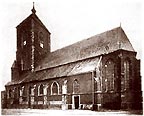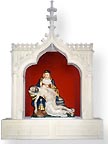St. Walburga —
the Ramsdorf Parish Church
St. Walburga — Die
Pfarrkirche zu Ramsdorf

—Excerpt
from the booklet published by St. Walburga Church following restoration
of the church in 1978
 The
renovation of the parish church in Ramsdorf in 1978 produced new
realizations about the history of the parish, and of the history
of the place of worship in particular.
The
renovation of the parish church in Ramsdorf in 1978 produced new
realizations about the history of the parish, and of the history
of the place of worship in particular.
The Ramsdorf parish
church. The 1899 photo shows the southeast side of the church
before the changes of 1912-1914. The three nave church was built
about 1410. Click image to enlarge
It is believed that the first Christian community
existed here around the year 1200. There were surely already Christians
in the local area.; however, concrete proof of that cannot be
found. A wooden chapel probably already existed before that time,
which is backed up by historical data. Around 1200 Ramsdorf was
branched off from the main parish in Borken. In the year 1212
the first priest responsible for Ramsdorf is mentioned, Albertus
sacerdos (priest Albert). The abbess of the Vreden district created
this parish. The baptismal font in the "Bentheimer"style
and a part of a archway in the old sacristy dates to this period.
In that era the original stone church was constructed in the roman
architectural style. The foundations of this first stone church
were exposed 1978. A field stone floor dates to that time also.
Further excavations revealed the exterior
walls and columns of an early gothic church. This would have been
constructed around the year 1280. In the choir area of the church
skeletons were excavated and portions of the vestments were made
of leather, which points to priests' graves.
At the beginning 15th century a large three
hall church was erected, of which the essential components remain
to our time. In the choir area of this church was a foundation-stone
inscribed with the year 1410. At first this church did not have
a tower. A gothic tower was added one hundred years later. The
foundation-stone over the main entrance, which is decorated by
figures of the mother of God, St. Vitalis and St. Walburga, displays
the year 1513.
When the tower was later added to the church
they cut through the arches between the columns and cut triangle
out of the curve of the tower arch.
The inside dimensions of the church remained
the same from the 15th century into our century. In the meantime
they tried to remedy the lack of space by adding another level
in the tower of the church.
In the years 1912 through 1914 came the expansion
of the church to the way it is today. The expansion was completed
following the plans of Sunder-Plaßmann, a Münster architect.
 Today
the church outline is in the shape of a cross. The expansion of
1912 includes today's transverse hall (referred to as "octagon"
in the vernacular) and the apse with the old main altar.
Today
the church outline is in the shape of a cross. The expansion of
1912 includes today's transverse hall (referred to as "octagon"
in the vernacular) and the apse with the old main altar.
Over
approximately 800 years the population Ramsdorf toiled for their
place of worship. Many sacrifices and much work were necessary,
in order to produce such a beautiful church and to adapt it according
to the needs of the times. Not the least of which are the rich
appointments with many statues of holy ones and many art objects
for God's sole use. Also the present generation has proved through
its 1978 renovation that it loves its church and no sacrifice
is too great.
A TOUR OF THE CHURCH
The steeple embodies the local image of Ramsdorf.
The three-storied brick building, animated with richly arranged
decoration, gives life and lightness to the sandstone tower. As
one steps through the portal of this tower, a large harmonious,
solemn room opens up.
 To
the left is Mary's chapel, the place for quiet prayer. The Pieta,
that painful mother, represents a special sanctuary for Ramsdorf.
This figure dates from the beginning of the 17th century. According
to local lore, it was was brought from Winterswijk [a few km to
the northwest in The Netherlands] to Ramsdorf during the reformation.
A number of gifts of thanks for answered prayers point to the
fact that in the past many people had sought and found comfort
before this image.
To
the left is Mary's chapel, the place for quiet prayer. The Pieta,
that painful mother, represents a special sanctuary for Ramsdorf.
This figure dates from the beginning of the 17th century. According
to local lore, it was was brought from Winterswijk [a few km to
the northwest in The Netherlands] to Ramsdorf during the reformation.
A number of gifts of thanks for answered prayers point to the
fact that in the past many people had sought and found comfort
before this image.
Each Christian's duty is to carry Christ. Therefore
the statue of St. Christopher stands in the entrance of the church's
nave both inviting and warning at the same time. The 2.23 meter
high statue is chiseled out of an oak trunk. Especially impressive,
the face of the Christopher presents itself. Two commemorative
plaques are mounted on the tower columns in honor and in the memory
of benefactors. They remind us of the Jungeblodt family and "breach
houses" which gave so much to the poor people of Ramsdorf
.
 The
exterior walls of the church are decorated with figures of the
most popular holy ones: Franciscus, Anthony, Alois, mother Anna
and others, all chiseled out of sandstone.
The
exterior walls of the church are decorated with figures of the
most popular holy ones: Franciscus, Anthony, Alois, mother Anna
and others, all chiseled out of sandstone.
Left:
St. Walburga statue over baptismal font
 A
special delight are the arch bases in the old part of the central
hall. In the vernacular these cute half figures are called "Duewelkes."
According to legend these figures represent elves [devils] which
were a nuisance on the graveyard at the Luensberg [a legendary
haunted graveyard 3 km south of Ramsdorf] and which frightened
people who went there. As punishment for that they must today
carry the arches of the place of worship.
A
special delight are the arch bases in the old part of the central
hall. In the vernacular these cute half figures are called "Duewelkes."
According to legend these figures represent elves [devils] which
were a nuisance on the graveyard at the Luensberg [a legendary
haunted graveyard 3 km south of Ramsdorf] and which frightened
people who went there. As punishment for that they must today
carry the arches of the place of worship.
In the middle in the church there are double columns
on the right of and on the left. Here the old building of 1410
and the new building of 1912 come together. In the vault a flower
painting suggests how the church once looked in former times.
Also end stones in the vault demonstrate the rich decoration of
the church.


In the transverse hall and in the choir area the
colorful glass windows are of special note. To the left the picture
of the patron saint, St. Walburga, to the right that of St. Boniface,
the first missionary to reach German soil. The choir windows represent
events from the life Jesus—birth, crucifixion and resurrection.
 The
baptismal font that stood in the back of the church earlier found
its new home in the niche on the right next to the choir room.
This font dates from the 12th century. It is decorated with vine
tendrils and grapes and a frieze of seven-pointed leaves on the
upper part. The base is adorned with grimacing figures that exhibit
partly human, partly animal traits. The beginning of Christianity—the
Sacrament of Holy Baptism—is still celebrated at this baptismal
font today.
The
baptismal font that stood in the back of the church earlier found
its new home in the niche on the right next to the choir room.
This font dates from the 12th century. It is decorated with vine
tendrils and grapes and a frieze of seven-pointed leaves on the
upper part. The base is adorned with grimacing figures that exhibit
partly human, partly animal traits. The beginning of Christianity—the
Sacrament of Holy Baptism—is still celebrated at this baptismal
font today.
back
to History Page